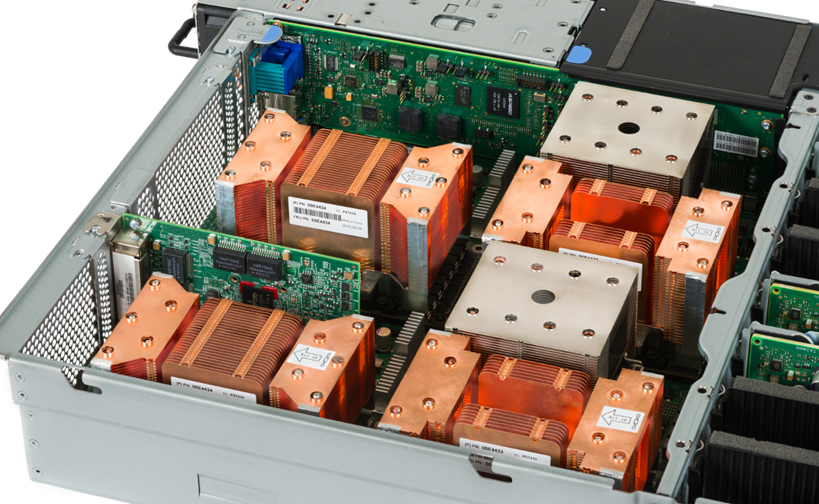IBM 'Minsky' HPC Boasts Two Power8 CPUs, Four Nvidia Tesla P100 GPUs
The popularity of IBM’s Power chips has been declining for decades, mainly to Intel’s benefit. However, after opening up the chip designs through the OpenPower Foundation backed by IBM, Google, Nvidia, and others, Power chips may be making a strong comeback at a time when the server chip market direly needs the competition.
IBM and Nvidia announced the results of their first collaboration with the release of the Power System S822LC for High-Performance Computing (code-named “Minsky”), containing two (updated) Power8 CPUs of between eight and ten cores each, and four Nvidia Tesla P100 GPUs. Keeping the data moving fast between them is Nvidia’s NVLink interconnect.
“Minsky” is the second system on the market to use Nvidia’s P100 GPU. The first was Nvidia’s DGX-1, which comes with eight P100 GPUs and can be used in combination with Intel processors.
The main difference between the two is that IBM’s servers (manufactured by Wistron) seem to have better integrated CPUs and GPUs, with faster bandwidth between the GPUs themselves and between the CPUs and the GPUs. Nvidia said that NVLink enables 5x faster data transfers between CPUs and GPUs compared to PCIe.
Intel’s chips aren’t compatible with NVLink, so the bandwidth between the Intel CPUs and Nvidia GPUs is limited to PCIe configurations. However, because of Nvidia's and IBM's partnerships, IBM can integrate and optimize its CPUs to work with NVLink.
“The open and collaborative model of the OpenPower Foundation has propelled system innovation forward in a major way with the launch of the IBM Power System S822LC for High Performance Computing,” said Ian Buck, VP of Accelerated Computing at Nvidia. “Nvidia NVLink provides tight integration between the Power CPU and Nvidia Pascal GPUs and improved GPU-to-GPU link bandwidth to accelerate time to insight for many of today’s most critical applications like advanced analytics, deep learning and AI,” he noted.
Tencent, a large internet service provider in China, has claimed that a cluster of IBM’s new chips can run workloads three times faster compared to the previous x86-based setup, while using only one-third of the number of servers. Impressed by the 9x improvement in efficiency (compared to a likely few-years-old x86 setup) that was enabled by IBM’s chips, Tencent is now integrating Power8 and Tesla P100-based servers into its data center.
Get Tom's Hardware's best news and in-depth reviews, straight to your inbox.
“The user insights and the business value you can deliver with advanced analytics, machine learning and artificial intelligence is increasingly gated by performance. Accelerated computing that can really drive big data workloads will become foundational in the cognitive era," said Doug Balog, General Manager of Power, IBM Systems. "Based on OpenPower innovations from partners such as Nvidia, our new OpenPower Linux servers with POWERAccel set a new standard for these workloads compared with x86 processor-based servers," he added.
Although IBM’s system seems to focus more on high-performance applications, the company also said that it’s targeting machine learning applications such as self-driving cars, real-time fraud protection, and the development of new drugs.
IBM’s new systems have already been ordered by “a large multinational retail corporation,” as well as by the U.S. Department of Energy’s Oak Ridge National Laboratory (ORNL) and Lawrence Livermore National Laboratory (LLNL). ORNL and LLNL want to use use IBM’s new servers as an early-generation development platform for applications that will be built for the Summit and Sierra supercomputers, which will be powered by IBM’s and Nvidia’s next-generation Power9 CPUs and Volta GPUs, respectively, while using the NVLink 2.0 interconnect.
Google has also recently announced that, together with Rackspace, it will begin using Power9-based servers in its own data centers. Opening up the Power design seems to have paid off for IBM, as now many large players in the server and supercomputer markets seem to be interesting in adopting Power chips once again, as an alternative to Intel’s solutions.
IBM said that its new systems can cost 30% less and offer up to 80% more performance per dollar spent compared to similarly-configured Intel-based systems. Online pricing for IBM's new systems begin at $5,999, and all configurations are generally available, with the exception of Power System S822LC for High-Performance Computing, which will ship on September 26.
Lucian Armasu is a Contributing Writer for Tom's Hardware US. He covers software news and the issues surrounding privacy and security.
-
bit_user While I welcome the revival of Power, I lament the rise of NVLink. If I were a customer with clout (e.g. Google, Facebook, Alibaba, etc.), I'd push Nvidia and IBM to offer support for PCIe 4.0, as soon as feasible. I'm continually amazed at the degree of vendor lock-in that Nvidia's customers are willing to accept. Proprietary APIs and languages, proprietary bus standards... what's next?Reply
Anyway, I'd love to hear about someone using these things for VR. Raytracing, just for starters...
BTW, I pretty much lost interest in ever owning a Mac, after they dropped PowerPC.
